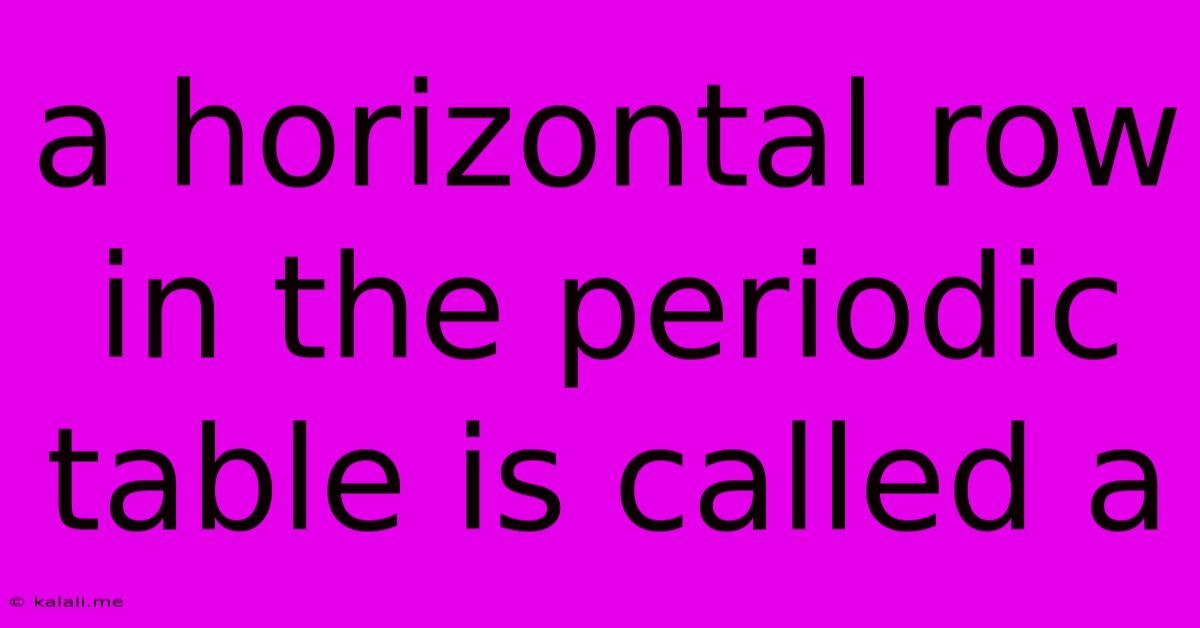A Horizontal Row In The Periodic Table Is Called A
Kalali
Jun 15, 2025 · 3 min read

Table of Contents
A Horizontal Row in the Periodic Table is Called a Period: Understanding the Organization of Elements
A horizontal row in the periodic table is called a period. Understanding the significance of periods is crucial to grasping the underlying principles of chemical behavior and the properties of elements. This article will delve into what periods represent, how they are organized, and the trends observed across them.
The periodic table, a cornerstone of chemistry, arranges elements based on their atomic number and recurring chemical properties. These properties are directly related to the electron configuration of the atoms, and the periods reflect the filling of electron shells.
What Defines a Period?
Each period corresponds to a principal energy level (or shell) in an atom. The first period, for example, only has elements with electrons in the first energy level (n=1). This shell can hold a maximum of two electrons, resulting in only two elements: hydrogen (H) and helium (He).
As you move down the periodic table to subsequent periods, more electron shells are added, leading to an increase in the number of elements within each period. The second period contains elements whose outermost electrons are in the second energy level (n=2), which can accommodate up to eight electrons. This explains why the second period contains eight elements, from lithium (Li) to neon (Ne).
Similarly, the third period also has eight elements (sodium (Na) to argon (Ar)), reflecting the filling of the third energy level. However, the subsequent periods become longer due to the filling of d and f sublevels, which are discussed below.
Trends Across a Period: A Closer Look
Elements within the same period exhibit trends in their properties. These trends are generally due to increasing effective nuclear charge (the net positive charge experienced by an electron) as you move from left to right across the period.
-
Atomic Radius: Atomic radius generally decreases across a period. This is because the increasing nuclear charge pulls the electrons closer to the nucleus.
-
Ionization Energy: Ionization energy, the energy required to remove an electron, generally increases across a period. The stronger attraction between the nucleus and electrons makes it harder to remove an electron.
-
Electronegativity: Electronegativity, the ability of an atom to attract electrons in a chemical bond, generally increases across a period. This is again due to the increasing nuclear charge.
-
Metallic Character: Metallic character generally decreases across a period. Elements on the left side of a period tend to be metals, while those on the right tend to be nonmetals.
Beyond the Basics: d and f block elements
Periods 4 and onward show an increase in the number of elements. This is due to the filling of the d and f orbitals (subshells). The transition metals (d-block elements) fill the d orbitals, and the lanthanides and actinides (f-block elements) fill the f orbitals, leading to the longer periods observed.
In summary, understanding periods and their characteristics is fundamental to comprehending the arrangement and properties of elements in the periodic table. This understanding provides a framework for predicting chemical behavior and forms the basis for many chemical concepts. By grasping the trends across a period, we gain valuable insights into the rich diversity of the elements.
Latest Posts
Latest Posts
-
80 Of X Is Equal To 100
Jun 15, 2025
-
What Are The First Five Multiples Of 5
Jun 15, 2025
-
What Is The Coefficient Of Discharge
Jun 15, 2025
-
Consider Steady State Conditions For One Dimensional Conduction
Jun 15, 2025
-
Difference Between High Pass And Low Pass Filter
Jun 15, 2025
Related Post
Thank you for visiting our website which covers about A Horizontal Row In The Periodic Table Is Called A . We hope the information provided has been useful to you. Feel free to contact us if you have any questions or need further assistance. See you next time and don't miss to bookmark.